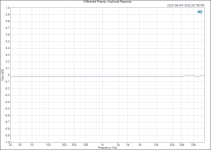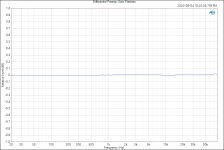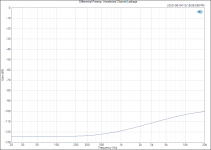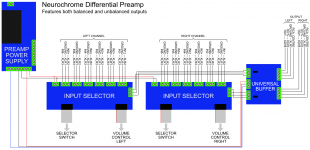When using the UB at the output of the differential preamp, if we want to connect an unbalanced source[...]
I'd use a pseudo-differential cable in that case: Pseudo-Differential Cable: Connect unbalanced source to balanced input – Neurochrome
You can also use an RCA/XLR adapter or permanently wire an RCA connector.
Tom
If you want two XLR outputs, you have two options:
The drawback of option 1) is that whatever is connected on one XLR output can affect the performance of the other output. Let's say, for example, that you have XLR out 1 connected to a power amp and XLR out 2 to a headphone amp. Turn the power amp off and its input impedance can get a bit wonky. This can affect the performance you'll have through the headphone amp (and vice versa).
- Use one UB and connect the balanced output to two XLR connectors.
- Use two UBs.
The drawback of option 2) is cost, though it does get you closer to my bulk discount thresholds... 😉
Tom
My use case would be one xlr to a power amp and the other to a DLCP for sub control or directly to the subs.
Using my THAT driver boards costs less even less than the UB. 🙂
So I will try it out with just THAT drivers on the inlet to the input switching board and no UB on the output. I can always add the UB or UBs later.
In general the THAT balanced drivers and receivers are not low noise. They have other attributes that make them desirable for higher common mode noise environments, such as long cable runs in live concerts. But they can only manage ~-100dBu output noise. This is because of the high internal resistor values in the chips themselves.
Whereas in a domestic application where CMRR is not as critical, you can, as Tom said, fairly straightforwardly (ie if you know what you are doing) achieve -110 to -120 dBu.
Craig
Whereas in a domestic application where CMRR is not as critical, you can, as Tom said, fairly straightforwardly (ie if you know what you are doing) achieve -110 to -120 dBu.
Craig
Hi Tom,
Am I correct in supposing that, if we don't want a volume control before the UB, we can use the setup below with appropriate shorting links placed in the pads for the left and right volume controls?
If I am correct, would it be possible for you to produce a graph of the CMRR vs. frequency for such a setup? Compared to the graph of CMRR vs. frequency which you provide on your site for the UB, this would show the effect (if any) of the source selector on the CMRR of the UB. It would be great if it turned out there's little or no effect (as I suspect).
Best regards.
Am I correct in supposing that, if we don't want a volume control before the UB, we can use the setup below with appropriate shorting links placed in the pads for the left and right volume controls?
If I am correct, would it be possible for you to produce a graph of the CMRR vs. frequency for such a setup? Compared to the graph of CMRR vs. frequency which you provide on your site for the UB, this would show the effect (if any) of the source selector on the CMRR of the UB. It would be great if it turned out there's little or no effect (as I suspect).
Best regards.
Attachments
You are correct that you can just connect the appropriate pins on the connector for the volume control to bypass it. Without a volume control, the CMRR of the differential preamp will be that of the Universal Buffer itself. The resistance in the input path is negligible and whatever resistance is there is balanced in the layout.
I shipped the two fully assembled input selector boards I had yesterday (that shipment was way overdue, but the power supply didn't' come in until yesterday). So I don't have a board handy to test. If you buy a fully assembled board I'm happy to check for you. I'll get you a good deal on the assembly... 😉
I did grab the same four graphs of the differential setup as I did for the single-ended. See attached.
Tom
I shipped the two fully assembled input selector boards I had yesterday (that shipment was way overdue, but the power supply didn't' come in until yesterday). So I don't have a board handy to test. If you buy a fully assembled board I'm happy to check for you. I'll get you a good deal on the assembly... 😉
I did grab the same four graphs of the differential setup as I did for the single-ended. See attached.
Tom
Attachments
Hi Tom,
Thanks for the offer. For differential mode stereo, I suppose I'll need two boards. I don't necessarily need the regulator though; I have a 5V supply available. Please quote by PM.
Thanks for posting these.
I'd be grateful if you'd share whether, in the test setup for "Unselected Channel Leakage", the "selected channel" is terminated with some particular value of source impedance, or it is only terminated by the input impedance of the "Differential Preamp".
Best regards.
If you buy a fully assembled board I'm happy to check for you. I'll get you a good deal on the assembly... 😉
Thanks for the offer. For differential mode stereo, I suppose I'll need two boards. I don't necessarily need the regulator though; I have a 5V supply available. Please quote by PM.
I did grab the same four graphs of the differential setup as I did for the single-ended. See attached.
Thanks for posting these.
I'd be grateful if you'd share whether, in the test setup for "Unselected Channel Leakage", the "selected channel" is terminated with some particular value of source impedance, or it is only terminated by the input impedance of the "Differential Preamp".
Best regards.
In the "unselected channel leakage" I drive an unselected channel with the AP (Zout = 30 Ω if I recall correctly). The unused channel is connected to the other channel of the AP (same Zout). I then measure the output of the preamp with the volume turned fully up.
Doug Self refers to this as the "offness" of the input selector. He has the better part of a chapter in his Small Signal book dedicated to this.
I'll toss you a PM in a second.
Tom
Doug Self refers to this as the "offness" of the input selector. He has the better part of a chapter in his Small Signal book dedicated to this.
I'll toss you a PM in a second.
Tom
Hi Tom,
PM received, thanks.
Thanks for sharing the "selected channel" source impedance for the "unselected channel leakage" test. It makes the graph much more valuable.
Best regards.
PM received, thanks.
In the "unselected channel leakage" I drive an unselected channel with the AP (Zout = 30 Ω if I recall correctly). The unused channel is connected to the other channel of the AP (same Zout).
Thanks for sharing the "selected channel" source impedance for the "unselected channel leakage" test. It makes the graph much more valuable.
Best regards.
Hi Tom,
I'm thinking of adding a mute relay (5 sec or so at startup) to the output of my UB bases preamp. I only use balanced inputs/outputs.
What is the best way to do this with the UB as output buffer:
- short pins 2 & 3 to ground
- connect pins 2 & 3
- leave pins 2 & 3 open
I guess it depends if the UB can handle a shorted output?
Thanks
I'm thinking of adding a mute relay (5 sec or so at startup) to the output of my UB bases preamp. I only use balanced inputs/outputs.
What is the best way to do this with the UB as output buffer:
- short pins 2 & 3 to ground
- connect pins 2 & 3
- leave pins 2 & 3 open
I guess it depends if the UB can handle a shorted output?
Thanks
I would use a small-signal relay to switch the output connector on your preamp between ground and the UB's output.
Tom
Tom
Tom, I am planning to use your UB to convert single ended sources to balanced to feed a balanced preamp. I have an unbalanced turntable and balanced DAC I would like to use with the preamp.
If I were to switch between multiple SE sources, I would have a rotary switch selecting the SE source --> UB outputting balanced. I would then plan to have a relay-based balanced input selector feeding into an attentuator feeding the preamp boards.
Should this work?
If I were to switch between multiple SE sources, I would have a rotary switch selecting the SE source --> UB outputting balanced. I would then plan to have a relay-based balanced input selector feeding into an attentuator feeding the preamp boards.
Should this work?
It sounds like you would like to have a balanced preamp with the option of connecting single-ended sources. That's easy: Build a differential/balanced preamp and connect the SE sources using a pseudo-differential connection, i.e. RCA shell to GND and IN-. RCA centre to IN+.
I happen to have such a relay-based Input Selector and Selector Switch in stock. You can use the Differential Volume Control with it and power it with a Preamp Power Supply.
Tom
I happen to have such a relay-based Input Selector and Selector Switch in stock. You can use the Differential Volume Control with it and power it with a Preamp Power Supply.
Tom
Attachments
Tom
Will I need a 100k pot? Can only find 10k ones at the moment, I'm looking for a motorised one.
Colin
Will I need a 100k pot? Can only find 10k ones at the moment, I'm looking for a motorised one.
Colin
100k is on the high side, lower is better as i've understood from Tom earlier. 10k is fine (i'ts what i use myself ALPS motorized 4-gang), 5k would be fine too if you can find them. But Tom will probably chime in as well..
Hopefully Tom will clarify. 100k was on the BOM for the original Diff Preamp, that's why I wondered.
Colin
Colin
Hopefully Tom will clarify. 100k was on the BOM for the original Diff Preamp, that's why I wondered.
100 kΩ was what was available at Mouser at the time. Lower is better. If 5 kΩ was available at Mouser, I'd recommend that. But 10 kΩ is the lowest they stock. 5 kΩ is custom order from ALPS. Minimum order quantity is 500 if you order via a distributor (or 50k if you order directly from ALPS). Ask me how I know... 😉
Tom
- Home
- Vendor's Bazaar
- Universal Buffer achieving -140 dBc (0.00001 %) THD





